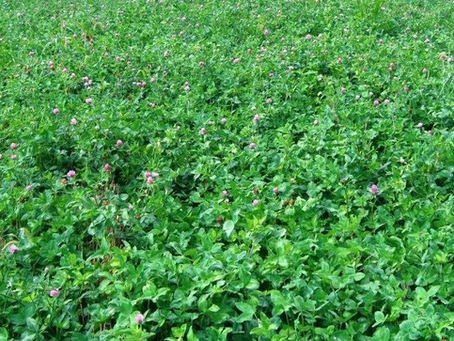Using Red Clover In Wheat To Increase Corn Yields

Frost seeding red clover into winter wheat as a cover crop has proven itself to have many agronomic benefits, including improving providing nitrogen (N), soil tilth, increased soil organic matter, reduced erosion and increased yields of the corn crop following in the rotation. The N credit and increased corn yields make the economics of the simple practice easy to justify.
Agronomic Benefits
In a typical year, about 40% of the winter wheat acres in Ontario are frost seeded with red clover. This practice has proven to have both short term N benefits and longer term soil and crop rotational benefits. There are no negative effects to winter wheat yields or protein content.
- Nitrogen Credit
OMAFRA Publication 811 “Agronomy Guide” suggests an N credit of 40 lbs/acre. This is likely very conservative where the stand is good and fairly uniform. The “Nitrogen Calculator” (http://www.gocorn.net/v2006/Ncalc/Ontario%20N%20calculator.xls) uses a 73 lbs/ac N credit where it is plowed or 60 lbs/ac where corn is no-tilled. Many agronomists and farmers use N credits varying from 50 to 80 lbs/acre. N credits are adjusted according to stand. Even short but fairly even red clover crops should provide 40 lbs/acre. N from red clover is mineralized over the corn growing season, particularly during June and July when corn N requirement are high. N credits are usually higher when incorporated with some tillage rather than no-till.
- Soil Tilth, Organic Matter & Reduced Erosion
Red clover has an extensive, fibrous root system in the top 6 inches of soil. This improves soil tilth and biological activity and attracts earthworm. Both top growth and growth below the soil level provide additional organic matter. Like other cover crops, red clover effectively reduces the risk of erosion.
- Increased Corn Yields
Long term rotational studies by the University of Guelph have shown corn yield increases of 7% where red clover was established in the winter wheat crop the previous year compared to winter wheat alone. This rotational effect is in addition to the N credit. Studies also suggest that the soil benefits and the yield benefits persist into the second and third years of the rotation. Other studies have shown situations where the yield increases are much greater. While it may be difficult to assign N credits to uneven spotty stands, even when N rates are not adjusted the corn yield increases will occur in field areas where red clover establishment is good.
Economic Benefits
Let’s make some assumptions and put some $ values to the N credit and corn yield benefits.
- N Credit
Assuming a seeding rate of 6 lbs/ac and seed at $3.25/lb, it costs about $19.50/ac. If we assume it costs $5.50/acre for application, the total cost will be $25/acre. Using an N credit of 60 lbs/ac and N priced at 60¢/lb, the N credit would be worth $36. This provides a net benefit of $11/acre before other long term soil and agronomic improvements, and increased corn yield benefits are even considered.
- Increased Corn Yields
The economic benefit of increased corn yields is actually larger than the N credit. If we assume a modest 7% yield increase in a corn crop averaging 170 bu/ac, the additional yield in the first year of corn is 12 bu/ac. Using a corn price of $4.50/bu, this provides an additional $54/acre. Even in a worse-case where only one-half the field has successful red clover establishment and no N credit is used, the increased corn yield makes this practice profitable.
Note that poor establishment when seeding red clover into winter wheat is covered under Agricorp Crop Insurance, reducing the risk by payouts that often exceed seed and application costs. The red clover can also provide an option of harvesting as haylage during years when local forage inventories are short, also helping in risk management for livestock producers.
- Seeding Red Clover
Red clover has excellent seedling vigour. It establishes easily and is shade tolerant under the wheat canopy. Red clover seed is typically broadcast with a tractor or ATV and a spinner spreader into winter wheat late-winter to early-spring when most of the snow is gone, and temperatures are below freezing at night and above during the day. This freeze-thaw cycle will provide good seed-to-soil contact for germination. If broadcast too early the snow melt can move seed. Broadcasting too late into wet, muddy soils has poor results.
Patchy, uneven red clover stands can result from:
- dry weather during June and July,
- poor soil conditions – poor drainage, compaction, eroded knolls, etc,
- uneven seeding,
- low seeding rates,
- low soil fertility or pH,
- no rhizobium present or inoculant, and
- uneven spreading of wheat straw behind the combine.
Red clover is commonly seeded into winter wheat at a rate of 6 – 10 lbs. Double-cut has more top growth and will provide a larger N credit. On occasion, this additional growth can interfere with wheat combining. Single-cut clover provides excellent root growth and is easier to control in the fall.
Red clover is usually terminated in late fall, allowing optimum root growth mass and soil benefits. Refer to OMAFRA Publication 75, “Guide To Weed Control”.
Bottom Line
Seeding red clover into winter wheat as a cover crop has many soil benefits, including improved soil tilth, increased soil organic matter, and reduced erosion. The cost of seeding red clover is more than covered by the additional nitrogen provided to the following corn crop. The most significant economic benefit is the increased corn yields that make this an excellent practice in corn-soy-wheat rotations. With a potential net gain of well over $65/ac in N and increased corn yields after seeding costs, can you really afford not to?
